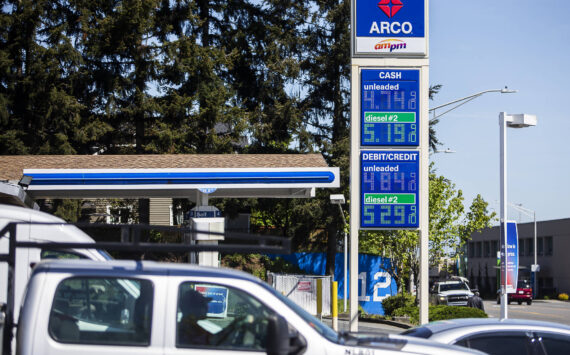Driven by record volume in total tonnage, containers, intermodal lifts and grain, the Port of Tacoma completed the strongest year by cargo volume in Port history. The Port’s 2005 volumes include:
— Tonnage: Record 20.4 million short tons up 8.3%
— Containers: Record 2.07 million TEUs (Twenty-Foot Equivalent Units) up 15% (international TEUs up 20.3%; domestic up 1.3%)
— Intermodal rail lifts: Record 633,620 up 29.4%
— Grain: Record 6.97 million short tons up 4.2%
— Breakbulk cargo: 116,680 short tons flat
— Autos: 135,900 units down 13.6%
Port of Tacoma Commission President Connie Bacon said the expansion of trans-Pacific trade and continued diversification of Port of entry by shippers helped fuel Tacoma’s growth. “The Port of Tacoma’s record-setting year is a reflection of our investment in facilities, infrastructure and regional transportation. It can also be attributed to the hard work and dedication of our customers, transportation partners, labor partners and our Port staff,” she said.
The Port invested $95 million in capital projects in 2005, highlighted by the grand opening of three new and renovated container terminals Pierce County Terminal (Evergreen Marine, Hatsu Marine and Lloyd Triestino), Husky Terminal (“K” Line) and Olympic Container Terminal (Yang Ming Line).
Timothy J. Farrell, Port of Tacoma Executive Director, emphasized that it wasn’t just expanded terminal capacity that drove the growth in container cargo, the entire transportation and logistics system has expanded. “One thing is clear about 2005 and the foreseeable future, and that is that international trade will continue to grow and our transportation system must grow with it,” he said. “We made great strides in system capacity in 2005, working closely with our terminal operators, Tacoma Rail and the BNSF Railway and Union Pacific Railroad. Our Tacoma longshore labor force also expanded, and in 2005 the number of longshore hours worked grew 31 percent to meet the demands of growing trade.
“All it takes is a look through our closets to see that we are all users of the freight transportation system,” Farrell continued. “Our clothes come from all over the world.
“We will continue to seek capacity enhancements through efficiency measures and infrastructure projects,” Farrell said. “Along the way, we’ll need the support of the federal government, as well as state and local governments and members of our local communities.”
NON-CONTAINERIZED CARGO
Bumper crops in the United States, combined with continued high demand for American corn and soybeans, created a record year for the Port’s grain export business. A record 6.97 million short tons surpassed the Port’s previous record 6.69 million short tons set in 2004.
In 2004, the Port’s breakbulk business expanded 14 percent to 116,884 short tons. In 2005, that growth was maintained with 2005 ending at 116,680 short tons essentially flat with a loss of 0.1 percent.
In 2005, the Port processed a total of 135,900 vehicles a 13.6 percent decrease. Port auto customers include five major automobile manufacturers Isuzu, Kia, Mazda, Mitsubishi and Suzuki.
PORT ECONOMIC IMPACTS
The economic impacts of cargo activity for the Tacoma-Pierce County region are significant, explained Bacon. “A study completed in 2005 documented the affects of trade growth through the Port of Tacoma,” she said. “The biggest benefit is job creation. More than 43,000 family-wage jobs in Pierce County are connected to Port activity, that’s a 52 percent increase from just four years ago.”
These economic impacts are felt statewide, according to the study. With efficient access to overseas markets for shippers, more than 1,350 Washington state firms import or export commodities through the Port of Tacoma. Statewide, this activity contributes to 113,100 family-wage jobs.
The study documents that the Port of Tacoma’s business and activities relating to it generate taxes for the state and local communities, which in turn, foster a higher standard of living. Throughout Washington state, Port of Tacoma activity generates an estimated $91 million per year in taxes. For Pierce County and its municipalities, more than $13.9 million is generated each year.
2006 PROJECTIONS
Looking ahead, Port officials expect 2006 to be a year of continued growth, particularly in international containerized cargo.
Farrell says 2006 will continue the Port of Tacoma’s extended period of growth in containerized cargo. “Each of our container terminals either has options to expand or is in the process of expansion,” he said, noting the Port’s five-year, $434 million capital improvement program. “As our container volume grows and we look to develop new maritime terminals, it is essential that our inland transportation infrastructure continues to offer our customers the capacity to meet their needs.”
According to Business Planning Manager Doug Ljungren, the Port’s 2006 cargo forecast includes:
— Total Tonnage: Record 21.8 million short tons up 7 percent
— Containerized Cargo: Record 2.4 million TEUs up 16 percent
— Intermodal Lifts: Record 732,000 up 15.5%
— Grain: 6.2 million short tons down 11 percent
— Breakbulk Cargo: 110,000 short tons down 6 percent
— Autos: 158,000 units up 16 percent




